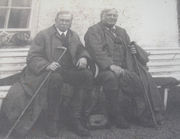
Ben Peach
Encyclopedia


Geologist
A geologist is a scientist who studies the solid and liquid matter that constitutes the Earth as well as the processes and history that has shaped it. Geologists usually engage in studying geology. Geologists, studying more of an applied science than a theoretical one, must approach Geology using...
.
He was born at Gorran Haven
Gorran Haven
Gorran Haven is a fishing village on the south coast of Cornwall, United Kingdom. It is situated approximately south of Mevagissey.The village lies in a cove between two sandy beaches...
in Cornwall to Charles William Peach
Charles William Peach
Charles William Peach was a British naturalist and geologist.-Biography:He was born at Wansford, Cambridgeshire; his father at the time was a saddler and harness-maker, and afterwards became an innkeeper, farming about eighty acres of land...
, an amateur British naturalist
Natural history
Natural history is the scientific research of plants or animals, leaning more towards observational rather than experimental methods of study, and encompasses more research published in magazines than in academic journals. Grouped among the natural sciences, natural history is the systematic study...
and geologist. Ben was educated at the Royal School of Mines
Royal School of Mines
Royal School of Mines comprises the departments of Earth Science and Engineering, and Materials at Imperial College London.- History :The Royal School of Mines was established in 1851, as the Government School of Mines and Science Applied to the Arts...
in London and then joined the Geological Survey in 1862 as a geologist, moving to the Scottish branch in 1867. He is best remembered for his work on the Northwest Highlands and Southern Uplands with his friend and colleague John Horne
John Horne
John Horne was a Scottish geologist. He was elected a Fellow of the Royal Society in 1900. He was a pupil of Ben Peach....
, where they resolved the long-running debate on the geological formation of the Highlands.
He was elected a Fellow of the Royal Society in 1892 The citation on his candidacy form read: "District Surveyor of the Geological Survey of Scotland. Past President of the Physical Society of Edinburgh. Recipient of the Wollaston Donation Fund of the Geological Society in 1887. For thirty years actively engaged on the Geological survey, during which time he has mapped many of the most complicated districts of Scotland. Has charge of the surveying of the NW Highlands, and has taken the leading part in unravelling the remarkable structural complications of that region. Author of various papers on palaeontological subjects: - 'On some New Crustaceans from the Lower Carboniferous Rocks of Eskale and Liddesdale' (Trans Roy Soc Edin, vol xxx, p. 73); 'On some new species of Fossil Scorpions from the Carboniferous Rocks of Scotland' (ibid, p 399); 'Further Researches among the Crustacea and Arachnida of the Carboniferous Rocks of the Scottish Border' (ibid, p 511); 'On some Fossil Myriapods from the Lower Old Red Sandstone of Forfarshire (Proc Roy Phys Soc Edin, vol vii, p 179). Joint author with Mr J Horne of many papers on stratigraphical and physical geology, including : - 'The Glaciation of the Shetland Isles' (Quart Journ Geol Soc, vol xxxv, p 778); 'The Glaciation of the Orkney Islands' (ibid, vol xxxvi, p 648); 'The Old Red Sandstone of Shetland' (Proc Roy Phys Soc Edin, vol v, p 30); 'The Glaciation of Caithness (ibid, vol vi, p 316); 'Report on the Geology of the North-West of Sutherland' (Nature, vol xxxi, p 31); 'The Old Red Sandstone Volcanic Rocks of Shetland' (Trans Roy Soc Edin, vol xxxii, p 539); 'Report on the Recent Work of the Geological Survey in the North-West Highlands of Scotland, based on the Field Maps of B N Peach, J Horne, W Gunn, C T Clough, L Hinxman, and H M Cadell' (Quart Journ Geol Soc, vol xliv, p. 378). "
He won the Wollaston Medal
Wollaston Medal
The Wollaston Medal is a scientific award for geology, the highest award granted by the Geological Society of London.The medal is named after William Hyde Wollaston, and was first awarded in 1831...
of the Geological Society in 1921. A monument to the work of Peach and Horne was erected at Inchnadamph
Inchnadamph
Inchnadamph is a hamlet in Assynt, Sutherland, Scotland. The name is an anglicisation of the Gaelic name Innis nan Damh meaning 'meadow of the stags'...
, close to the Moine Thrust
Moine Thrust Belt
The Moine Thrust Belt is a linear geological feature in the Scottish Highlands which runs from Loch Eriboll on the north coast 190 km south-west to the Sleat peninsula on the Isle of Skye...
where they did some of their best-known work. The inscription reads: "To Ben N Peach and John Horne who played the foremost part in unravelling the geological structure of the North West Highlands 1883-1897. An international tribute. Erected 1980."
He died in Edinburgh in 1926.
See also
- Knockan CragKnockan CragKnockan Crag is a line of cliffs in Assynt, Scotland north of Ullapool. The name is an anglicisation of the Gaelic Creag a' Chnocain meaning 'crag of the small hill'....
- InchnadamphInchnadamphInchnadamph is a hamlet in Assynt, Sutherland, Scotland. The name is an anglicisation of the Gaelic name Innis nan Damh meaning 'meadow of the stags'...
- North West Highlands GeoparkNorth West Highlands GeoparkThe North West Highlands Geopark is a geopark in the Scottish Highlands. Awarded UNESCO geopark status in 2004, it features some of the oldest rocks in Europe, around 3,000 million years old...
- Geology of ScotlandGeology of ScotlandThe geology of Scotland is unusually varied for a country of its size, with a large number of differing geological features. There are three main geographical sub-divisions: the Highlands and Islands is a diverse area which lies to the north and west of the Highland Boundary Fault; the Central...
External links
- Ben Peach archive

